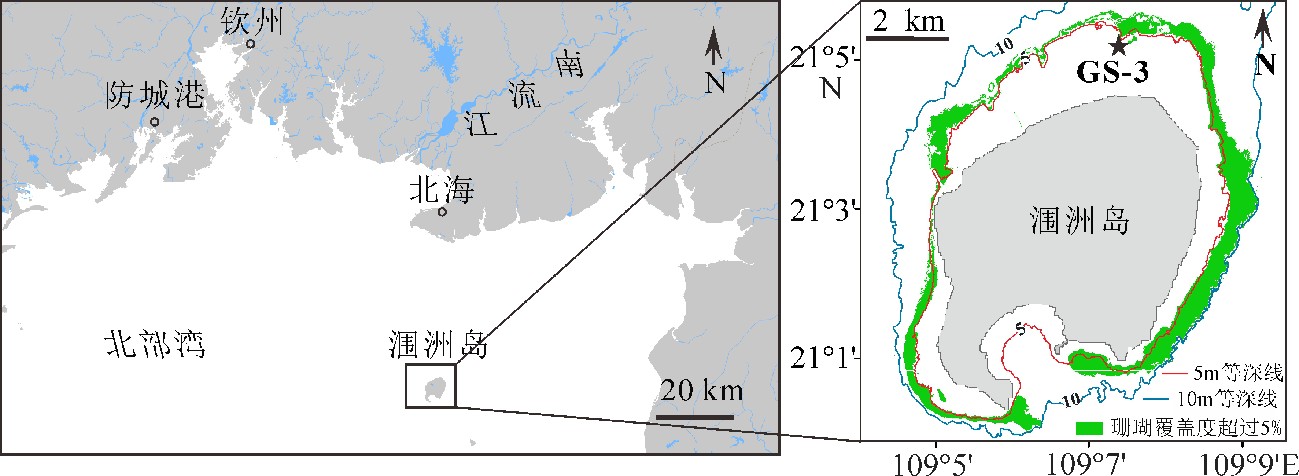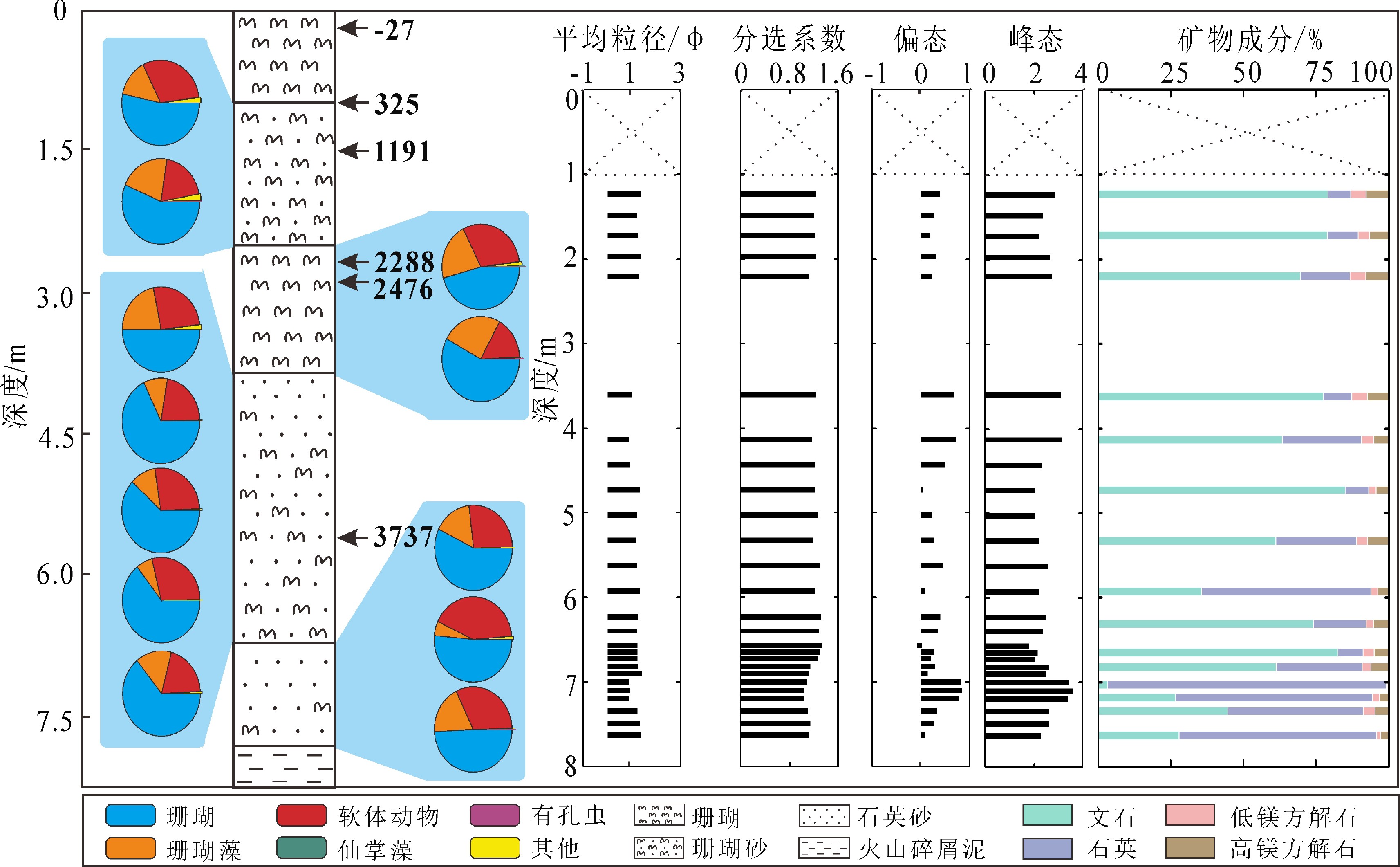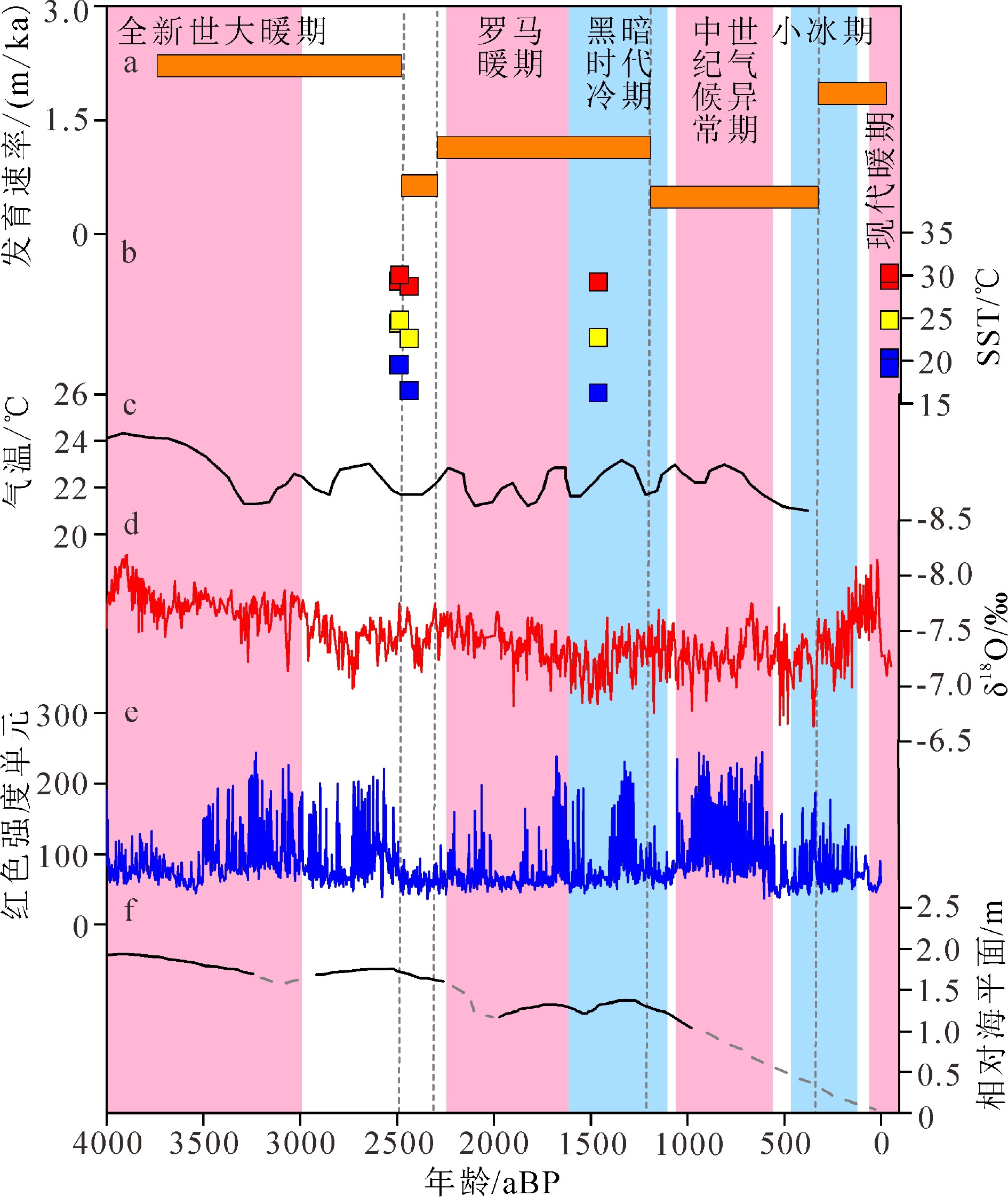Development of coral reefs around Weizhou Island and its bearing on climate
-
摘要: 涠洲岛位于热带北缘,对珊瑚生长而言其纬度相对偏高,冬季低温是制约其珊瑚生长和珊瑚礁发育的关键因素。重建涠洲岛珊瑚礁发育的过程,对于了解珊瑚对过去气候的响应以及预测珊瑚礁的发育趋势等具有重要科学意义。以涠洲岛珊瑚礁钻孔(GS-3)为材料,利用高精度铀系测年技术测定珊瑚年龄,建立涠洲岛珊瑚礁发育的年代框架;通过粒度、生物组分、矿物成分分析揭示了其物质组成。结果显示,GS-3岩芯5.57 m处的珊瑚铀系年代为3737±17 aBP(相对于公元1950年),基于此年代计算的珊瑚礁平均发育速率为1.49 m/ka。在3737~2476、2288~1191以及325 aBP以来涠洲岛珊瑚礁快速发育,其发育速率分别为2.21、1.13及1.85 m/ka;在2476~2288、1191~325 aBP珊瑚礁缓慢发育,发育速率分别为0.64、0.48 m/ka。沉积物的生物组分主要为珊瑚、珊瑚藻和软体动物;矿物成分主要为文石和石英。基于珊瑚礁发育速率与气候背景的关系对比,得出涠洲岛珊瑚礁快速发育阶段与全新世大暖期后期、罗马暖期以及现代暖期大致对应;缓慢发育阶段与降温期、黑暗时代冷期后期、中世纪气候异常期、小冰期前期大致对应。总体来看,相对高纬度的涠洲岛珊瑚礁的发育快慢受气候冷暖所调控,暖期的气候有利于珊瑚生长和珊瑚礁发育,冷期珊瑚礁发育慢。Abstract: The Weizhou Island, located in the northern border of the tropics, is relatively too high in latitude to coral growth. Low temperature in winter time is the key factor which limits the coral growth and reef development. Reconstructing the development of coral reefs on the Weizhou Island is of great scientific significance for understanding the response of corals to past climate and predicting the development trend of coral reefs in the future. This study is devoted to the drilling cores extracted from the Well GS-3 on the Weizhou Island. The cores were dated with high-precision uranium series dating, upon which the chronological framework of the coral reefs is established. Particle size, biological composition and mineral composition are analyzed for revealing the composition of the coral deposits. The age of the coral reefs at 5.57 m in depth of the core GS-3 is dated 3737 ± 17 aBP. The average vertical accretion rate of the coral reefs is 1.49 m/ ka calculated based on this age. The growth of coral reefs on the Weizhou Island were accelerated during the periods of 3737~2476 aBP, 2288~1191 aBP and 325 years ago to present with vertical accretion rates of 2.21 m/ka, 1.13 m/ka and 1.85 m/ka respectively, and decelerated during the periods of 2476~2288 aBP and 1191~325 aBP and the correspondent vertical accretion rates were 0.64 m/ ka and 0.48 m/ka respectively. The biological components of sediments are mainly composed of corals, coralline algae and mollusks, while the mineral compositions dominated by aragonite and quartz. The correlation between coral reef vertical accretion rate and its climate background suggests that the rapid development stage of coral reefs on the Weizhou Island could roughly correlated to the Late Megathermal Period, Roman Warm Period and Current Warm Period, and the slowing down stages of development of reefs roughly corresponded to the cold periods, namely the Late Dark Ages Cold Period, the Medieval Climate Anomaly and the early Little Ice Age. In general, the development of coral reefs on the Weizhou Island at relatively high latitudes is depending on climate changes. The warm periods are conducive to coral growth and otherwise, coral reefs growth would slow down as cold periods came.
-
Keywords:
- coral reef /
- U-Th age /
- accretion rate /
- late Holocene /
- Weizhou Island
-
浮游有孔虫壳体元素组成作为重要的海洋环境参数替代性指标,在古海洋学研究中发挥着重要的作用。随着浮游有孔虫壳体元素比值测试技术的快速发展,通过对浮游有孔虫壳体元素比值的分析,取得了一系列重要成果[1-3]。其中,Globigerinoides ruber(白色)和Trilobatus sacculifer壳体作为定量重建地质历史时期表层海水温度和盐度的重要信息载体,得到了广泛的研究和应用[1, 4-5]。然而,在利用G. ruber和T. sacculifer壳体进行测试时,通常忽略G. ruber和T. sacculifer不同形态类型的壳体对重建结果的可能影响。
大部分海洋沉积物样品中G. ruber壳体存在两种形态类型,分别为狭义种(sensu stricto, s.s.)和广义种(sensu lato, s.l.)。根据分类学标准,G. ruber s.s. 壳体的主要形态为:一个近球形房室对称地生长于原有结构上,而形成具有高角度拱形的较大口孔;而G. ruber s.l. 壳体具有相对紧凑的结构特征:一个扁平的房室不对称地生长于原有结构之上,从而形成具有中等角度的拱形和相对较小的口孔[6]。研究发现浮游有孔虫G.ruber壳体的两种形态类型具有不同的稳定同位素组成,且G. ruber s.s.的生活水深浅于G. ruber s.l.,因此两种形态类型的G. ruber壳体记录的海洋环境信息可能存在差异[4, 7-8]。此外,也有研究发现热带和亚热带海区G. ruber s.s.和G. ruber s.l.壳体的元素比值也存在差异[4, 9]。
T. sacculifer作为另外一个重要的浮游有孔虫混合层水种,其壳体在古海洋学研究中也得到了广泛的应用[10-11]。尽管从分类学角度来看,T. sacculifer的分类更加复杂,但其在形态方面的主要区分依据为是否具有最后一个似袋状房室[12]。因此,T. sacculifer从形态学上可以分为T. sacculifer(with sac)和T. sacculifer(without sac)。Elderfield等[11]和 Anand等[13]通过对取自大西洋的沉积岩芯以及沉积物捕获器样品的分析,发现T. sacculifer(with sac)和T. sacculifer(without sac)壳体的元素比值同样存在一定的差异。
已有研究表明有孔虫壳体的Sr/Ca比值在第四纪以来存在着明显的冰期-间冰期变化特征,可能是指示海水Sr/Ca水平的潜在替代性指标[14-15]。此外,有孔虫壳体Sr/Ca比值的变化可能可以指示第四纪冰期旋回中的海平面变化[16]。也有研究发现浮游有孔虫壳体的Sr/Ca受海水温度和盐度等因素的影响[17]。因此,有孔虫壳体Sr/Ca是古海洋学研究的潜在指标之一。本文通过西菲律宾海MD06-3047B岩芯中G. ruber s.s.和G. ruber s.l.以及T. sacculifer
(with sac)和T. sacculifer(without sac)壳体Sr/Ca比值的测试分析,探讨它们之间是否存在着显著性差异,并分析不同形态类型壳体Sr/Ca比的影响因素,为未来利用两个浮游有孔虫表层水种在该区域开展古海洋学工作提供借鉴。 1. 材料与方法
1.1 研究材料
MD06-3047B岩芯(17º00.44′N、124º47.93′E)位于吕宋岛以东约240 km的西菲律宾海本哈姆高原(图1a),水深2510 m。该沉积岩芯沉积连续, 没有发现明显的沉积间断以及浊流沉积层,沉积柱状样主要由黄色粉砂质泥组成。根据前人研究,西菲律宾海现代碳酸盐溶跃面深度约为3400 m [18],MD06-3047B孔位于海区溶跃面深度之上,因此该沉积物岩芯中有孔虫保存程度较好[19]。在本次研究中,我们选取钻孔岩芯上部60 cm,按4 cm间隔取样,取得15个层位的样品。每个层位样品分别挑选30~50枚粒径范围为250~300 μm的G. ruber s.s.、G. ruber s.l.、T. sacculifer(with sac)和T. sacculifer
(without sac)壳体(图2)。并对这59个有孔虫样品(G. ruber s.s.有一层位缺失)进行Sr/Ca比值测试。尽管G. ruber和T. sacculifer的生活水深存在差异,但两者的平均钙化深度均位于混合层内[7, 13],该层内海水温度和盐度随深度的变化较小(图1b)。 1.2 壳体元素测试
有孔虫壳体的清洗主要依据Barker等[21]的方法。首先,将有孔虫壳体在显微镜下压碎,保证每个房室均被打开;分别对每一个有孔虫样品用去离子水进行超声清洗5次、乙醇(优级纯)超声清洗2 次、去离子水清洗2 次,用以去除黏土等;用加热的H2O2缓冲溶液进行氧化处理,并用去离子水进行清洗,以去除有机质等;在镜下剔出非有孔虫壳体碎片的杂物(暗色矿物、絮尘等);转移并进行淋洗保存等待上机测试。元素测试在中国科学院海洋研究所电感耦合等离子发射光谱仪(ICP-OES)上进行。通过对标准溶液(Sr/Ca=1.20 mmol/mol)进行45次重复测试分析,得到Sr/Ca测试的标准偏差为1.1% (1σ)。
1.3 统计分析
为了从统计学角度分析G.ruber和T. sacculifer
不同形态类型壳体的Sr/Ca比值差异,我们依照Antonarakou等[8]的方法,对MD06-3047B岩芯中上述4类有孔虫壳体的Sr/Ca测试结果进行韦尔奇检验。首先,假设相比较的两组数据均值结果相当,如果G.ruber s.s.和G. ruber s.l.或T. sacculifer (with sac)和T. sacculifer(without sac)壳体的Sr/Ca结果相当,即接受虚假设(H=H0),说明G.ruber或T. sacculifer不同形态类型的Sr/Ca比值的差异不大;相反,如果对比结果存在显著差异,即拒绝虚假设(H=Ha),说明不同形态类型壳体的Sr/Ca存在显著差异。 2. 壳体Sr/Ca结果
MD06-3047B孔的年龄框架由Jia等建立[19],主要依据全球大洋底栖有孔虫氧同位素堆叠曲线[22],并辅以粉红色G. ruber末现面(~120 ka)作为参考点[23]而确立。本次研究的样品时间跨度约48 ka,覆盖了MIS 3-1。图3所示为MD06-3047B孔MIS 3期以来的G.ruber s.s. 和G. ruber s.l. 以及T. sacculifer(with sac)和T. sacculifer(without sac)壳体的Sr/Ca比值。48 ka以来 G.ruber s.s.和G. ruber s.l.壳体的Sr/Ca整体上具有相同的变化趋势,其差值变化范围为−0.006~0.022 mmol/mol,平均差值约0.006 mmol/mol。G. ruber(白色)的两种形态类型壳体的Sr/Ca比值并没有表现出明显的阶段性高低变化规律,但G.ruber s.l.壳体Sr/Ca波动幅度相对较大。T. sacculifer(with sac)和T. sacculifer(without sac)壳体Sr/Ca比值存在差异,整体上T. sacculifer(with sac)壳体的Sr/Ca比值相对较高,两者的差值变化范围为−0.008~0.034 mmol/mol,平均约0.017mmol/mol。
![]() 图 3 MD06-3047B孔G. ruber s.s.、G. ruber s.l.、T. sacculifer(with sac)和T. sacculifer(without sac)壳体的Sr/Ca比值,以及G. ruber和T. sacculifer不同形态类型壳体Sr/Ca差值Figure 3. Shell Sr/Ca of G. ruber s.s., G. ruber s.l., T. sacculifer (with sac), and T. sacculifer (without sac) from Core MD06-3047B, and the difference in shell Sr/Ca between morphotypes of the species
图 3 MD06-3047B孔G. ruber s.s.、G. ruber s.l.、T. sacculifer(with sac)和T. sacculifer(without sac)壳体的Sr/Ca比值,以及G. ruber和T. sacculifer不同形态类型壳体Sr/Ca差值Figure 3. Shell Sr/Ca of G. ruber s.s., G. ruber s.l., T. sacculifer (with sac), and T. sacculifer (without sac) from Core MD06-3047B, and the difference in shell Sr/Ca between morphotypes of the species3. 讨论
3.1 G.ruber和T. sacculifer 不同形态类型壳体Sr/Ca差异
如图3所示,G.ruber s.s.和G. ruber s.l.壳体Sr/Ca变化趋势较为一致,平均差值仅约0.006 mmol/mol,小于Sr/ Ca比值的测试误差(± 0.011 mmol/mol)。T. sacculifer(with sac)和T. sacculifer(without sac)壳Sr/Ca平均差值为约0.017 mmol/mol,大于测试误差(± 0.011 mmol/mol)。同时,统计学韦尔奇检验结果也显示G.ruber s.s.和G. ruber s.l. 壳体Sr/Ca平均值差异结果不具有显著差异;而T. sacculifer(with sac)和T. sacculifer(without sac)壳Sr/Ca平均值差异显著(p<0.05,表1)。综上,我们判断在MD06-3047B站位的附近海区G. ruber不同形态类型壳体Sr/ Ca比值的差异较小;而T. sacculifer不同形态类型壳体Sr/Ca的差异较大。因此,在西菲律宾海区对浮游有孔虫表层水种Sr/Ca比值进行测试分析时,如在样品量不足的情况下,可以选择G. ruber的不同形态类型壳体,但需要尽量选择T. sacculifer(with sac)或T. sacculifer
(without sac)的单一形态类型壳体,以免造成结果偏差。 表 1 MD06-3047B孔G. ruber s.s.和G. ruber s.l.以及T. sacculifer(with sac)和T. sacculifer(without sac)壳体Sr/Ca平均值(mmol/mol)以及韦尔奇检验结果(p<0.05)Table 1. Mean shell Sr/Ca (mmol/mol) of G. ruber s.s., G. ruber s.l., T. sacculifer (with sac), and T. sacculifer (without sac) of Core MD06-3047B with the results of the Welch’s t-test at p<0.05 levelSr/Ca Sr/Ca G.ruber s.s. 1.393 G.sacculifer (without sac) 1.383 G.ruber s.l. 1.387 G.sacculifer (with sac) 1.401 H H0 H Ha 注:其中H = H0表示接受虚假设,H = Ha表示拒绝虚假设。 3.2 不同形态类型壳体Sr/Ca差异的影响因素
浮游有孔虫壳体Sr/Ca主要受到海水Sr/Ca、海水温度、盐度和溶解作用等因素的影响[17, 24-27]。根据前人关于海水Sr/Ca的冰期-间冰期变化特征的研究可知,海水Sr/Ca在冰期时高,而在间冰期时低[28-29]。这一特征与我们的结果并不完全一致(图4),特别是MIS 3期的Sr/Ca整体低于MIS 1期。此外,不同形态类型壳体的Sr/Ca变化并没有表现出完全一致的变化,也说明其他因素在其中发挥作用。因此,海水Sr/Ca可能不是影响研究区浮游有孔虫壳体Sr/Ca变化特征的唯一因素。有研究表明,G.ruber
壳体Sr/Ca可能受到海水温度和盐度的影响,而受pH的影响较小[26],随着海水温度和盐度的升高,G.ruber壳体Sr/Ca呈增大趋势。T. sacculifer壳体Sr/Ca同样受到温度和盐度的影响[27],海水温度升高,T. sacculifer壳体Sr/Ca越大,而盐度越高,Sr/Ca越小。 如图3和图4所示,同一粒径范围下,MIS 3期以来G. ruber两种形态类型的壳体Sr/ Ca十分相似,说明两者的变化可能受到相同影响因素的控制。而T. sacculifer(with sac)和T. sacculifer(without sac)壳体Sr/Ca存在显著差异(本文3.1节),可能指示二者受不同因素的影响。进一步将G.ruber s.s.、G. ruber s.l.、T. sacculifer(with sac)和T. sacculifer(without sac)壳体Sr/Ca进行对比可发现(图4),G.ruber s.s.、G. ruber s.l.和T. sacculifer(without sac)壳体Sr/Ca呈现较为一致的变化趋势,并两两进行线性相关分析,发现三组记录之间具有较好的相关性,因此这两个种的3种形态类型壳体Sr/Ca的记录可能受到相同因素的影响。为方便分析,将这三组记录进行堆叠平均(Sr/Castack),并与同站位48 ka以来的表层海水温度和盐度等古海洋学记录[19]进行对比和线性相关分析。结果显示Sr/Castack与表层海水温度呈现线性正相关(图5a),从整体趋势上,G.ruber s.s.、G. ruber s.l.和T. sacculifer (without sac)的Sr/Ca的增大对应表层海水温度的升高(图4)。而Sr/Castack与表层海水盐度替代性指标(δ18Osw-ice)之间不具有明显的相关性(图5b),并且G.ruber s.s.、G. ruber s.l.和T. sacculifer(without sac)壳体Sr/Ca与表层海水盐度的变化趋势也存在较大差异(图4)。因此,研究区G.ruber s.s.、G. ruber s.l.和T. sacculifer(without sac)壳体的Sr/Ca变化可能主要受到表层海水温度的影响,而受到盐度的影响较小。其中,Sr/Ca的高值并未完全出现在MIS 1期,而整体出现在末次冰消期,即MIS 2期向MIS 1期的过渡阶段(图4)。这可能是由于太平洋区域存在显著的末次冰消期表层海水温度显著增暖的特征[30]。此外,MD06-3047B孔年龄框架由底栖有孔虫氧同位素建立,而根据前人工作,研究区SST在变化特征上超前于底栖有孔虫氧同位素的变化[31]。
![]() 图 5 MD06-3047B孔浮游有孔虫表层水种Sr/Ca与表层海水温度和盐度记录[19]的线性相关分析SST为表层海水温度,δ18Osw-ice为表层海水盐度替代性指标(高值指示高盐),Sr/Castack为G.ruber s.s.、G. ruber s.l.和T. sacculifer(without sac)壳体Sr/Ca记录的堆叠结果。Figure 5. Linear correlation of shell Sr/Ca ratio of planktonic surface-water-dwelling foraminifer species and sea surface temperature and salinity[19] from Core MD06-3047BSST: sea surface temperature, δ18Osw-ice: the proxy of sea surface salinity (high δ18Osw-ice means higher salinity), Sr/Castack: the stack of Sr/Ca records of G.ruber s.s., G. ruber s.l., and T. sacculifer (without sac).
图 5 MD06-3047B孔浮游有孔虫表层水种Sr/Ca与表层海水温度和盐度记录[19]的线性相关分析SST为表层海水温度,δ18Osw-ice为表层海水盐度替代性指标(高值指示高盐),Sr/Castack为G.ruber s.s.、G. ruber s.l.和T. sacculifer(without sac)壳体Sr/Ca记录的堆叠结果。Figure 5. Linear correlation of shell Sr/Ca ratio of planktonic surface-water-dwelling foraminifer species and sea surface temperature and salinity[19] from Core MD06-3047BSST: sea surface temperature, δ18Osw-ice: the proxy of sea surface salinity (high δ18Osw-ice means higher salinity), Sr/Castack: the stack of Sr/Ca records of G.ruber s.s., G. ruber s.l., and T. sacculifer (without sac).由于T. sacculifer(with sac)壳体Sr/Ca与G.ruber s.s.、G. ruber s.l.和T. sacculifer(without sac)的变化趋势存在明显差异(图4),故将其单独进行分析。如图5c和图5d所示,T. sacculifer (with sac)壳体Sr/Ca与表层海水温度记录无显著相关性,而与表层海水盐度呈反相关。因此,T. sacculifer(with sac)壳体的Sr/Ca可能主要受表层海水盐度的影响,这一关系与Dissard等的研究结果一致[27]。
4. 结论
通过对西太平洋暖池北部边缘海区MD06-3047B孔中浮游有孔虫表层水种G.ruber(G.ruber s.s.与G. ruber s.l.)和T. sacculifer(T. sacculifer(with sac)与T. sacculifer(without sac))壳体的Sr/ Ca进行分析,发现MIS 3期以来,G. ruber不同形态类型壳体的Sr/ Ca差异较小;而T. sacculifer不同形态类型壳体的Sr/ Ca相差较大。因此,在利用G. ruber和T. sacculifer 壳体的Sr/Ca结果重建古海洋信息的过程中,如在样品量有限的条件下,可以选择G. ruber壳体不同形态类型进行测试,但应尽量选择T. sacculifer单一形态类型壳体。不同形态类型壳体Sr/Ca与海水温度和盐度古海洋学记录对比显示,研究区G.ruber s.s.、G. ruber s.l.和T. sacculifer(without sac)壳体Sr/Ca可能主要受海水温度的影响;T. sacculifer(with sac)壳体Sr/Ca主要受到盐度的影响。
致谢:感谢中法合作MARCO POLO 2航次的全体工作人员在取样过程中提供的帮助。
-
图 3 4000年来涠洲岛珊瑚礁的发育速率与古气候代用指标的对比
a. 涠洲岛珊瑚礁发育速率: 全新世大暖期[41]; 罗马暖期[42]; 黑暗时代冷期, 中世纪气候异常期, 小冰期和现代暖期[43]; 粉色阴影和蓝阴影分别代表暖期和冷期; b. 南海雷州半岛珊瑚Sr/Ca指示的SST[48-49]:红点表示平均最大SST, 黄点表示年平均SST, 蓝点表示平均最小SST; c. 珠江三角洲孢粉指示的气温[46]; d. 贵州董哥洞石笋δ18O指示的东亚夏季风[47]; e. 赤道东太平洋沿岸湖泊纹层色度指示的ENSO活动[60]; f. 珊瑚指示的南海相对海平面[57]。
Figure 3. Correlation between the development rate of coral reefs on Weizhou Island and paleoclimate proxy in the past 4000 years
(a) Coral reef development rate on Weizhou island: Megathermal[41]; Roman Warm Period[42]; Dark Age Cold, Medieval Climate Anomaly, Little Ice Age and Current Warm Period[43]; Pink-shaded bars and blue-shaded bars represent warm and cold periods, respectively; (b) SST indicated by coral from Leizhou Peninsula in the South China Sea, refers to Yu et al, 2005[48] and Wei et al, 2004[49]: red dot indicates the mean maximum SST, yellow dot indicates the mean annual SST and blue dot indicates the mean minimum SST; (c)Temperature indicated by sporopollen in the Zhujiang Delta, refers to Li et al, 1991[46]; (d) East Asian summer monsoon indicated by δ18O of Dongge cave in Guizhou, refers to Conroy et al, 2008[47]; (e) ENSO variability indicated by red color intensity of lake sediments on the coast of eastern equatorial pacific area, refers to Moy et al, 2002[60]; (f) Relative sea level indicated by coral in the South China Sea, refers to Yu et al, 2012[57].
表 1 涠洲岛GS-3井珊瑚样品U-Th测年结果统计表
Table 1 U-Th dating results of coral samples from Well GS-3, Weizhou Island
样品
编号深度/m U/10−6 232Th/10-9 (230Th/232Th) (230Th/238U) (234U/238U) 230Th年龄/a δ234U
(初始值T)未校正 校正 日历年
/aBPGS3-1 0.34 3.3380±0.0036 5.125±0.008 1.71±0.02 0.00086±0.00001 1.1466±0.0014 82±1 42±20 −27±20 146.6±14 GS3-2 0.99 2.7900±0.0034 7.336±0.014 5.60±0.06 0.00485±0.00005 1.1481±0.0015 462±5 394±34 325±34 148.4±15 GS3-3 1.41 3.0110±0.0027 3.599±0.006 34.26±0.21 0.01350±0.00008 1.1466±0.0016 1291±8 1260±17 1191±17 147.1±16 GS3-4 2.66 3.3952±0.0039 2.487±0.005 102.32±0.44 0.02471±0.00010 1.1456±0.0015 2376±10 2357±14 2288±14 146.6±15 GS3-5 2.78 3.0751±0.0033 0.913±0.001 270.6±1.00 0.02649±0.00010 1.1445±0.0018 2553±10 2545±11 2476±11 145.5±18 GS3-6 5.57 2.8853±0.0029 2.413±0.003 143.15±0.43 0.03945±0.00011 1.1430±0.0018 3828±13 3806±17 3737±17 144.6±18 注:括号中的比率是依据Cheng等[37]公布的衰变常数以原子比计算的活度比;所有数值均已根据实验室空白样进行了校正;所有U-Th 数据误差为2s;未校正的 230Th年龄(a)使用Isoplot 3.75程序计算;δ234U =[(234U/238U)−1]×1000。BP表示距1950AD。 表 2 涠洲岛GS-3井珊瑚礁沉积物组成
Table 2 Composition of coral reef sediments in Well GS-3 of Weizhou Island
分层 深度
/m岩心描述 粒度 生物组分 矿物成分 发育
类型1 0~1 主要为2~5 cm的枝状珊瑚(70%)、块状珊瑚(25%)的枝、砾,以及少量砂质组分(5%),偶见螺类、贝壳类的碎片。多数珊瑚碎屑的表面疏松多孔且有绿色藻类附着,其孔洞内存在大量现代双壳类、蠕虫等侵蚀生物 平均粒径为砾(>−1Φ),
分选差鹿角珊瑚属、蜂巢珊瑚属以及滨珊瑚属的珊瑚枝、砾为主,偶见软体动物 文石 原生珊瑚 2 1~2.4 块状珊瑚砾(70%)和砂质组分(30%) 平均粒径为中砂(1.29Φ),
分选较差,偏态呈近对称,峰态宽平54.79%珊瑚,25.01%软体动物,17.72%珊瑚藻,2.33%其他(蠕虫为主),零星有孔虫、仙掌藻 75.9%文石,12.31%方解石,11.79%石英 原生珊瑚、陆源输入 3 2.4~3.8 2~5 cm的大型块状珊瑚(90%)和砂质组分(10%) 平均粒径为粗砂(0.99Φ),
分选较差,偏态呈正偏分布,峰态很宽平51.89%珊瑚,25.12%珊瑚藻,16.27%软体动物,零星有孔虫、仙掌藻 77.52%文石,12.73%方解石,9.75%石英 原生珊瑚、陆源输入 4 3.8~6.8 枝状珊瑚(60%)和砂质组分(40%) 平均粒径为中砂(1.18Φ),
分选较差,偏态为正偏,峰态宽平61.61%珊瑚,24.76%软体动物,珊瑚藻(6.77%~21.76%)含量变化较大 66.98%文石,24.68%石英,8.33%方解石 原生珊瑚、陆源输入 5 6.8~7.6 块状珊瑚(40%)和砂质组分(60%),其间夹少量贝壳碎屑 中砂(1.11Φ),分选较差,偏态呈正偏,峰态
很宽平52.60%珊瑚,33.38%软体动物,13.33%珊瑚藻,零星有孔虫、仙掌藻 61.58%石英,32.73%文石,5.69%方解石 陆源输入、原生珊瑚 6 7.6~8.2 黄绿色火山碎屑泥 粉砂,分选好 细小有孔虫、贝类 石英,火山碎屑等复杂成分 陆源输入 -
[1] Bruno J F, Selig E R. Regional Decline of Coral Cover in the Indo-Pacific: Timing, Extent, and Subregional Comparisons [J]. PLoS One, 2007, 2(8): e711. doi: 10.1371/journal.pone.0000711
[2] Gardner T A, Cote I M, Gill J A, et al. Long-term region-wide declines in Caribbean corals [J]. Science, 2003, 301(5635): 958-960. doi: 10.1126/science.1086050
[3] Bellwood D R, Hughes T P, Folke C, et al. Confronting the coral reef crisis [J]. Nature, 2004, 429(6994): 827-833. doi: 10.1038/nature02691
[4] Hoegh-Guldberg O, Mumby P J, Hooten A J, et al. Coral reefs under rapid climate change and ocean acidification [J]. Science, 2007, 318(5857): 1737-1742. doi: 10.1126/science.1152509
[5] Hughes T P, Graham N A J, Jackson J B C, et al. Rising to the challenge of sustaining coral reef resilience [J]. Trends in Ecology & Evolution, 2010, 25(11): 633-642.
[6] Pandolfi J M, Connolly S R, Marshall D J, et al. Projecting Coral Reef Futures Under Global Warming and Ocean Acidification [J]. Science, 2011, 333(6041): 418-422. doi: 10.1126/science.1204794
[7] Beger M, Sommer B, Harrison P L, et al. Conserving potential coral reef refuges at high latitudes [J]. Diversity and Distributions, 2014, 20(3): 245-257. doi: 10.1111/ddi.12140
[8] Yamano H, Sugihara K, Nomura K. Rapid poleward range expansion of tropical reef corals in response to rising sea surface temperatures [J]. Geophysical Research Letters, 2011, 38(4): L04601.
[9] Booth D J, Figueira W F, Gregson M A, et al. Occurrence of tropical fishes in temperate southeastern Australia: Role of the East Australian Current [J]. Estuarine, Coastal and Shelf Science, 2007, 72(1-2): 102-114. doi: 10.1016/j.ecss.2006.10.003
[10] Baird A H, Sommer B, Madin J S. Pole-ward range expansion of Acropora spp. along the east coast of Australia [J]. Coral Reefs, 2012, 31(4): 1063-1063. doi: 10.1007/s00338-012-0928-6
[11] Precht W F, Aronson R B. Climate Flickers and Range Shifts of Reef Corals [J]. Frontiers in Ecology and the Environment, 2004, 2(6): 307-314. doi: 10.1890/1540-9295(2004)002[0307:CFARSO]2.0.CO;2
[12] Serrano E, Coma R, Ribes M. A phase shift from macroalgal to coral dominance in the Mediterranean [J]. Coral Reefs, 2012, 31(4): 1199-1199. doi: 10.1007/s00338-012-0939-3
[13] Serrano E, Coma R, Ribes M, et al. Rapid Northward Spread of a Zooxanthellate Coral Enhanced by Artificial Structures and Sea Warming in the Western Mediterranean [J]. PLoS One, 2013, 8(1): e52739. doi: 10.1371/journal.pone.0052739
[14] Qin Z J, Yu K F, Wang Y H, et al. Spatial and Intergeneric Variation in Physiological Indicators of Corals in the South China Sea: Insights Into Their Current State and Their Adaptability to Environmental Stress [J]. Journal of Geophysical Research:Oceans, 2019, 124(5): 3317-3332. doi: 10.1029/2018JC014648
[15] Qin Z J, Yu K F, Liang Y T, et al. Latitudinal variation in reef coral tissue thickness in the South China Sea: Potential linkage with coral tolerance to environmental stress [J]. Science of the Total Environment, 2020, 711: 134610. doi: 10.1016/j.scitotenv.2019.134610
[16] Yu W J, Wang W H, Yu K F, et al. Rapid decline of a relatively high latitude coral assemblage at Weizhou Island, northern South China Sea [J]. Biodiversity and Conservation, 2019, 28(14): 3925-3949. doi: 10.1007/s10531-019-01858-w
[17] Clark T R, Chen X F, Leonard N D, et al. Episodic coral growth in China's subtropical coral communities linked to broad-scale climatic change [J]. Geology, 2019, 47(1): 79-82. doi: 10.1130/G45278.1
[18] Yan S, Zhao J X, Lau A Y A, et al. Episodic Reef Growth in the Northern South China Sea linked to Warm Climate During the Past 7, 000 Years: Potential for Future Coral Refugia [J]. Journal of Geophysical Research:Biogeosciences, 2019, 124(4): 1032-1043. doi: 10.1029/2018JG004939
[19] 余克服, 蒋明星, 程志强, 等. 涠洲岛42年来海面温度变化及其对珊瑚礁的影响[J]. 应用生态学报, 2004, 15(3):506-510 doi: 10.3321/j.issn:1001-9332.2004.03.030 YU Kefu, JIANG Mingxing, CHENG Zhiqiang, et al. Latest forty two years’ sea surface temperature change of Weizhou Island and its influence on coral reef ecosystem [J]. Chinese Journal of Applied Ecology, 2004, 15(3): 506-510. doi: 10.3321/j.issn:1001-9332.2004.03.030
[20] 梁文, 黎广钊. 涠洲岛珊瑚礁分布特征与环境保护的初步研究[J]. 环境科学研究, 2002, 15(6):5-7,16 doi: 10.3321/j.issn:1001-6929.2002.06.002 LIANG Wen, LI Guangzhao. Preliminary study on characteristics of coral reef distribution and environmental protection in Weizhou Island [J]. Research of Environmental Sciences, 2002, 15(6): 5-7,16. doi: 10.3321/j.issn:1001-6929.2002.06.002
[21] 周雄, 李鸣, 郑兆勇, 等. 近50年涠洲岛5次珊瑚冷白化的海洋站SST指标变化趋势分析[J]. 热带地理, 2010, 30(6):582-586 doi: 10.3969/j.issn.1001-5221.2010.06.002 ZHOU Xiong, LI Ming, ZHENG Zhaoyong, et al. An analysis on the trend of sea surface temperature indices for coral cold bleaching in Weizhou Island ocean observation station during 1960-2009 [J]. Tropical Geography, 2010, 30(6): 582-586. doi: 10.3969/j.issn.1001-5221.2010.06.002
[22] 刘敬合, 黎广钊, 农华琼. 涠洲岛地貌与第四纪地质特征[J]. 广西科学院学报, 1991, 7(1):27-36 LIU Jinghe, LI Guangzhao, NONG Huaqiong. Features of geomorphy and quaternary geology of the Weizhou Island [J]. Journal of the Guangxi Academy of Sciences, 1991, 7(1): 27-36.
[23] 叶维强, 黎广钊, 庞衍军, 等. 北部湾涠洲岛珊瑚礁海岸及第四纪沉积特征[J]. 海洋科学, 1988, 12(6):13-17 YE Weiqiang, LI Guangzhao, PANG Yanjun, et al. Characteristics of the coastal reef and quaternary sediment from the Weizhou Island, Beibu Gulf [J]. Marine Sciences, 1988, 12(6): 13-17.
[24] 黎广钊, 梁文, 农华琼, 等. 涠洲岛珊瑚礁生态环境条件初步研究[J]. 广西科学, 2004, 11(4):379-384 doi: 10.3969/j.issn.1005-9164.2004.04.027 LI Guangzhao, LIANG Wen, NONG Huaqiong, et al. Preliminary study on conditions of coral reef ecological environment along the coast of Weizhou Island [J]. Guangxi Sciences, 2004, 11(4): 379-384. doi: 10.3969/j.issn.1005-9164.2004.04.027
[25] 邱绍芳. 涠洲岛附近海域水质和底质环境的分析与评价[J]. 广西科学院学报, 1999, 15(4):170-173 QIU Shaofang. Analysis and evaluation of substrate environment and water quality of the sea area around Weizhou Island [J]. Journal of Guangxi Academy of Sciences, 1999, 15(4): 170-173.
[26] 韦蔓新, 赖廷和, 何本茂. 涠洲岛水域生物理化环境特征及其相互关系[J]. 海洋科学, 2003, 27(2):67-71 doi: 10.3969/j.issn.1000-3096.2003.02.020 WEI Manxin, LAI Tinghe, HE Benmao. The biological and physical and chemical characteristics of environment and their matual relationships in the waters of Weizhou Island [J]. Marine Sciences, 2003, 27(2): 67-71. doi: 10.3969/j.issn.1000-3096.2003.02.020
[27] Chen T R, Li S, Yu K F, et al. Increasing temperature anomalies reduce coral growth in the Weizhou Island, northern South China Sea [J]. Estuarine, Coastal and Shelf Science, 2013, 130: 121-126. doi: 10.1016/j.ecss.2013.05.009
[28] 黄晖, 马斌儒, 练健生, 等. 广西涠洲岛海域珊瑚礁现状及其保护策略研究[J]. 热带地理, 2009, 29(4):307-312,318 doi: 10.3969/j.issn.1001-5221.2009.04.001 HUANG Hui, MA Binru, LIAN Jiansheng, et al. Status and conservation strategies of the coral reef in Weizhou Island, Guangxi [J]. Tropical Geography, 2009, 29(4): 307-312,318. doi: 10.3969/j.issn.1001-5221.2009.04.001
[29] 王文欢, 余克服, 王英辉. 北部湾涠洲岛珊瑚礁的研究历史、现状与特色[J]. 热带地理, 2016, 36(1):72-79 WANG Wenhuan, YU Kefu, WANG Yinghui. A Review on the research of coral reefs in the Weizhou Island, Beibu Gulf [J]. Tropical Geography, 2016, 36(1): 72-79.
[30] Yu K F, Zhao J X, Wang P X, et al. High-precision TIMS U-series and AMS 14C dating of a coral reef lagoon sediment core from southern South China Sea [J]. Quaternary Science Reviews, 2006, 25(17-18): 2420-2430. doi: 10.1016/j.quascirev.2006.01.027
[31] Clark T R, Roff G, Zhao J X, et al. Testing the precision and accuracy of the U-Th chronometer for dating coral mortality events in the last 100 years [J]. Quaternary Geochronology, 2014, 23: 35-45. doi: 10.1016/j.quageo.2014.05.002
[32] McManus J F, Anderson R F, Broecker W S, et al. Radiometrically determined sedimentary fluxes in the sub-polarNorth Atlantic during the last 140, 000 years [J]. Earth and Planetary Science Letters, 1998, 155(1-2): 29-43. doi: 10.1016/S0012-821X(97)00201-X
[33] Chen T R, Roff G, Feng Y X, et al. Tropical Sand Cays as Natural Paleocyclone Archives [J]. Geophysical Research Letters, 2019, 46(16): 9796-9803. doi: 10.1029/2019GL084274
[34] Toth L T, Aronson R B, Vollmer S V, et al. ENSO drove 2500-year collapse of eastern Pacific coral reefs [J]. Science, 2012, 337(6090): 81-84.
[35] 曲高生. 西沙群岛琛航岛碳酸盐沉积物X射线定量分析方法研究[J]. 矿物学报, 1990, 10(4):360-369 doi: 10.3321/j.issn:1000-4734.1990.04.010 QU Gaosheng. Quantitative X-ray diffraction analysis of carbonate sediments from Chenhang Island, Xisha Island, China: a methodological study [J]. Acta Mineralogica Sinica, 1990, 10(4): 360-369. doi: 10.3321/j.issn:1000-4734.1990.04.010
[36] Shen C C, Li K S, Sieh K, et al. Variation of initial 230Th/ 232Th and limits of high precision U–Th dating of shallow-water corals [J]. Geochimica et Cosmochimica Acta, 2008, 72(17): 4201-4223.
[37] Cheng H, Edwards R L, Hoff J, et al. The half-lives of uranium-234 and thorium-230 [J]. Chemical Geology, 2000, 169(1-2): 17-33. doi: 10.1016/S0009-2541(99)00157-6
[38] 樊祺诚, 孙谦, 隋建立, 等. 北部湾涠洲岛及斜阳岛火山岩微量元素和同位素地球化学及其构造意义[J]. 岩石学报, 2008, 24(6):1323-1332 FAN Qicheng, SUN Qian, SUI Jianli, et al. Trace-element and isotopic geochemistry of volcanic rocks and it’s techtonic implications in Weizhou Island and Xieyang Island, Northern Bay [J]. Acta Petrologica Sinica, 2008, 24(6): 1323-1332.
[39] 王国忠, 全松青, 吕炳全. 南海涠洲岛区现代沉积环境和沉积作用演化[J]. 海洋地质与第四纪地质, 1991, 11(1):69-82 WANG Guozhong, QUAN Songqing, LV Bingquan. Evolution of modern sedimentary environments and sedimentations in the Weizhou Island area, south China sea [J]. Marine Geology & Quaternary Geology, 1991, 11(1): 69-82.
[40] 余克服, 钟晋梁, 赵建新, 等. 雷州半岛珊瑚礁生物地貌带与全新世多期相对高海平面[J]. 海洋地质与第四纪地质, 2002, 22(2):27-33 YU Kefu, ZHONG Jinliang, ZHAO Jianxin, et al. Biological-geomorphological zones in a coral reef area at southwest Leizhou Peninsula unveil multiple sea level high-stands in the Holocene [J]. Marine Geology & Quaternary Geology, 2002, 22(2): 27-33.
[41] 施雅风, 孔昭宸, 王苏民, 等. 中国全新世大暖期的气候波动与重要事件[J]. 中国科学 (B辑), 1994, 37(3):353-365 SHI Yafeng, KONG Zhaochen, WANG Sumin, et al. The climate fluctuation and important events of Holocene Megathermal in China [J]. Science in China. Series B, Chemistry, Life Science & Earth Sciences, 1994, 37(3): 353-365.
[42] Lam H H. Climate: present, past and future[M]. London: Methuen, 1977.
[43] 黄博津, 余克服, 陈特固. 过去2000年的特征气候时段及其影响因素[J]. 海洋地质与第四纪地质, 2013, 33(1):97-108 HUANG Bojin, YU Kefu, CHEN Tegu. Recent progress on specific climatic stages and driving forces over last 2000 years [J]. Marine Geology & Quaternary Geology, 2013, 33(1): 97-108.
[44] Mann M E, Zhang Z H, Rutherford S, et al. Global Signatures and Dynamical Origins of the Little Ice Age and Medieval Climate Anomaly [J]. Science, 2009, 326(5957): 1256-1260.
[45] 黎广钊, 梁文, 廖思明, 等. 广西沿海全新世以来气候变化[J]. 海洋地质与第四纪地质, 1996, 16(3):49-60 LI Guangzhao, LIANG Wen, LIAO Siming, et al. Climatic changes since Holocene along Guangxi coast [J]. Marine Geology & Quaternary Geology, 1996, 16(3): 49-60.
[46] 李平日, 方国祥, 黄光庆. 珠江三角洲全新世环境演变[J]. 第四纪研究, 1991, 11(2):130-139 doi: 10.3321/j.issn:1001-7410.1991.02.005 LI Pingri, FANG Guoxiang, HUANG Guangqing. Holocene environmental changes in Zhujiang delta [J]. Quaternary Sciences, 1991, 11(2): 130-139. doi: 10.3321/j.issn:1001-7410.1991.02.005
[47] Conroy J L, Overpeck J T, Cole J E, et al. Holocene changes in eastern tropical Pacific climate inferred from a Galápagos lake sediment record [J]. Quaternary Science Reviews, 2008, 27(11-12): 1166-1180. doi: 10.1016/j.quascirev.2008.02.015
[48] Yu K F, Zhao J X, Wei G J, et al. Mid-late Holocene monsoon climate retrieved from seasonal Sr/Ca and δ18O records of Porites lutea corals at Leizhou Peninsula, northern coast of South China Sea [J]. Global and Planetary Change, 2005, 47(2-4): 301-316. doi: 10.1016/j.gloplacha.2004.10.018
[49] Wei G J, Yu K F, Zhao J X. Sea surface temperature variations recorded on coralline Sr/Ca ratios during Mid-Late Holocene in Leizhou Peninsula [J]. Chinese Science Bulletin, 2004, 49(17): 1876-1881.
[50] 张婷, 胡敏航, 张文静, 等. 涠洲岛珊瑚礁近千年的发育过程及其对气候变化的响应[J]. 热带海洋学报, 2020, 39(4):70-79 ZHANG Ting, HU Minhang, ZHANG Wenjing, et al. Coral reef growth of Weizhou Island and its response to climate change in the past millennium [J]. Journal of Tropical Oceanography, 2020, 39(4): 70-79.
[51] Davies P J, Montaggioni L. Reef growth and sea-level change: the environmental signature[C]//Proceedings of the Fifth International Coral Reef Symposium. Tahiti: Martin, 1985: 477-515.
[52] Sarg J F. Carbonate Sequence Stratigraphy[M]//Wilgus C K, Hastings B S, Kendall C G S C, et al. SEPM Special Publication: Sea-Level Changes-An Integrated Approach. Society of Economic Paleontologists and Mineralogists, 1988: 155-181.
[53] Vecsei A. A new estimate of global reefal carbonate production including the fore-reefs [J]. Global and Planetary Change, 2004, 43(1-2): 1-18. doi: 10.1016/j.gloplacha.2003.12.002
[54] Hongo C, Kayanne H. Holocene coral reef development under windward and leeward locations at Ishigaki Island, Ryukyu Islands, Japan [J]. Sedimentary Geology, 2009, 214(1-4): 62-73. doi: 10.1016/j.sedgeo.2008.01.011
[55] Hamanaka N, Kan H, Yokoyama Y, et al. Disturbances with hiatuses in high-latitude coral reef growth during the Holocene: Correlation with millennial-scale global climate change [J]. Global and Planetary Change, 2012, 80-81: 21-35. doi: 10.1016/j.gloplacha.2011.10.004
[56] 余克服, 陈特固. 南海北部晚全新世高海平面及其波动的海滩沉积证据[J]. 地学前缘, 2009, 16(6):138-145 doi: 10.3321/j.issn:1005-2321.2009.06.015 YU Kefu, CHEN Tegu. Beach sediments from northern South China Sea suggest high and oscillating sea level during the lat Holocene [J]. Earth Science Frontiers, 2009, 16(6): 138-145. doi: 10.3321/j.issn:1005-2321.2009.06.015
[57] 余克服. 南海珊瑚礁及其对全新世环境变化的记录与响应[J]. 中国科学:地球科学, 2012, 55(8):1217-1229 doi: 10.1007/s11430-012-4449-5 YU Kefu. Coral reefs in the South China Sea: Their response to and records on past environmental changes [J]. Science China Earth Science, 2012, 55(8): 1217-1229. doi: 10.1007/s11430-012-4449-5
[58] Hoegh-Guldberg O, Fine M, Skirving W, et al. Coral bleaching following wintry weather [J]. Limnology and Oceanography, 2005, 50(1): 265-271. doi: 10.4319/lo.2005.50.1.0265
[59] Yu K F, Zhao J X, Liu T S, et al. High-frequency winter cooling and reef coral mortality during the Holocene climatic optimum [J]. Earth and Planetary Science Letters, 2004, 224(1-2): 143-155. doi: 10.1016/j.jpgl.2004.04.036
[60] Moy C M, Seltzer G O, Rodbell DT, et al. Variability of El Niño/Southern Oscillation activity at millennial timescales during the Holocene epoch [J]. Nature, 2002, 420(6912): 162-165. doi: 10.1038/nature01194
-
期刊类型引用(12)
1. 李林致,郭刚,廖计华,王欣,李婧婧,吴斌,张晓庆. 丽水-椒江凹陷月桂峰组湖相烃源岩的主控因素与分布预测. 海洋地质前沿. 2024(04): 9-17 .  百度学术
百度学术
2. 何雁兵 ,雷永昌 ,邱欣卫 ,肖张波 ,郑仰帝 ,刘冬青 . 珠江口盆地陆丰南地区文昌组沉积古环境恢复及烃源岩有机质富集主控因素研究. 地学前缘. 2024(02): 359-376 .  百度学术
百度学术
3. 郑仰帝,彭光荣,肖张波,黄鑫,何雁兵,杨兴业. 古近系文昌组湖盆古环境及其对烃源岩的控制作用——以珠江口盆地陆丰15洼为例. 华南地震. 2024(01): 11-24 .  百度学术
百度学术
4. 郭奕浩,曾德铭,张芮,王兴志,黄董,张本健,谢圣阳. 川中—川东地区侏罗系大安寨段古环境及油气地质意义. 沉积学报. 2024(03): 1016-1031 .  百度学术
百度学术
5. 阙晓铭,舒誉,汪旭东,雷永昌,王宇辰,吴琼玲. 珠一坳陷古近纪物源特征及其沉积演化:来自碎屑锆石年龄的指示. 地球科学. 2024(07): 2373-2387 .  百度学术
百度学术
6. 耿名扬,刘志峰,吴斌. 渤海海域秦南凹陷沙河街组烃源岩沉积环境及发育模式. 大庆石油地质与开发. 2024(06): 20-28 .  百度学术
百度学术
7. 党昭卿,陈莹,吕成福,白志钊,肖月也,周钱山. 利用三角洲前积层的厚度恢复湖泊最大古水深:以渤海湾盆地秦南凹陷和珠江口盆地惠州凹陷为例. 高校地质学报. 2024(06): 726-736 .  百度学术
百度学术
8. 谢世文,柳保军,庞雄,丁琳,吴宇翔,刘冬青,王宇辰. 珠江口盆地白云凹陷裂陷期沉积环境演化与控烃作用. 天然气地球科学. 2023(02): 296-311 .  百度学术
百度学术
9. 阙晓铭,雷永昌,汪旭东,贾连凯,宋伟. 珠江口盆地陆丰南文五段低矿化度水化学特征及成因分析. 中国海上油气. 2023(02): 23-32 .  百度学术
百度学术
10. 林义华,梁定勇,魏昌欣,吕昭英,吴迪,黄武轩,许国强,杜鹃. 海南岛西北部晚更新世海滩岩地球化学特征及其古环境意义. 科学技术与工程. 2023(10): 4079-4090 .  百度学术
百度学术
11. 贾培蒙,杜家元,陈维涛,杨兴业,熊万林,靳瑶瑶. 断陷盆地边缘洼陷优质烃源岩形成机制——以珠江口盆地惠州26洼东北次洼为例. 海洋地质与第四纪地质. 2022(03): 140-148 .  本站查看
本站查看
12. 古榕,王智闻,周华. 准噶尔南缘中段上侏罗统—下白垩统沉积古环境分析. 中国锰业. 2022(05): 11-15 .  百度学术
百度学术
其他类型引用(4)




 下载:
下载:









